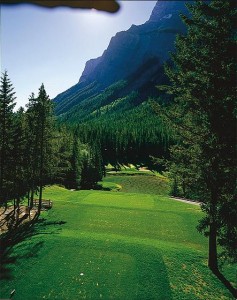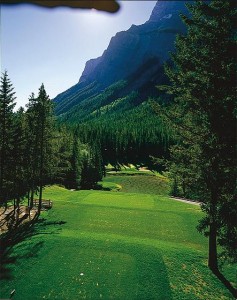Situated a mile high in the Canadian Rockies, Banff Springs is without question one of the most spectacular settings in the world for a golf course. Visitors like James Levine travel across the continent to take in the scenery, and sometimes they get more than they bargained for – a very special round of golf.
“My wife and I came out from New York to take a walking tour through the Canadian Rockies. We arrived a few days before the tour began to take a look at Lake Louise, which we’d always heard about. After taking in the Lake, I went to look at the Banff Springs course. One look, and I just had to play. In a moment of incredible generosity, my wife let me take a day off the hike to play the course. Better yet, she agreed to walk the course. After all the years we’ve been married, it was the first time she’d ever been out on the course with me. She came away thinking that a trek on the course was every bit as visually fantastic as the hikes we did on the mountain trails.”
That a golf course exists against such a rugged backdrop is a tale of continental expansion, wartime spoils and envy – the makings of a good opera, one might say! In the 1880s, the railroads were pushing west across Canada. At certain points along the way, great hotels were built, in keeping with the philosophy of Canadian Pacific Railway’s General Manager William Van Horne, who said that “If we can’t export the scenery, we will import the tourists.” Near the confluence of the Bow and Spray Rivers 80 miles west of Calgary, there were hot springs – built in tourist potential. So in 1886, the baronial Banff Springs hotel was commissioned; it opened in 1888, every bit as awe-inspiring as the mountains encircling the Bow Valley. Twenty years later, a basic 9-hole course was added to appeal to the burgeoning tourist trade. Near the end of World War I, a second nine was built, under the guidance of Donald Ross, with the labor provided primarily by German Prisoners of War. Visitors to Banff Springs circa 1920 found a beautiful setting, and a decent, if not awe-inspiring layout.
In 1926 Canadian Pacific’s rival, Canadian National Railroad, unveiled a golf course of their own, Jasper Park, four hours north of Banff Springs. Jasper Park was quickly hailed as one of the greatest courses in Canada – indeed, in the world. Rankled by this development, Canadian Pacific decided that they would have to have a world class course of their own to complement their grand hotel…and they hired Stanley Thompson, Jasper’s creator, to work his magic. Thompson, one of the greatest architects in a generation of great architects, expanded the course beyond its initial boundaries. Working with the ample top soil that his railroad client could easily provide, he built what was then the most expensive course ever constructed, topping $1,000,000. After it opened in 1929, it wasn’t long before Banff Springs was recognized as one of the top ten courses in the world.
Stanley Thompson surely recognized the grandeur of this site along the Bow River, and he sculpted the holes on a broad scale to maximize the impact of the vistas. The 535-yard par-5 third hole, named Gibraltar, is bounded on the right by the flanks of Mount Rundle, which climbs nearly a mile into the clouds. When approaching the green, the mountain still looms in the background, making it difficult to gauge the proper distance to the pin. Attempts to stick it close are further hampered by a putting surface that slopes toward the back. On several other holes, most notably the 445-yard par-4 14th called Wampum, the Banff Springs Hotel juts up behind the green, nearly as monolithic as the adjoining Rockies. The 15th hole, a 480-yard par-4 dubbed Spray, provides yet another incredible vista; players tee off from a precipice high above a tributary of the Spray River, with Mount Rundle again in the background. In the initial Thompson routing of the course, this was hole number one, and the tee shot was considered by many to be the game’s greatest opening play. The carry of roughly 150 yards to reach the fairway is not great considering the elevated tee and the thin air, yet the sheer take your breath away beauty of the setting is enough to unnerve previously unflappable players. If the first drive goes astray, take a Mulligan so you can watch your ball fly against the mountain.
No essay on Banff Springs is quite complete without a mention of the Devil’s Cauldron, perhaps golf’s most compelling par-3. Players come upon the tee from a path in the woods, and their jaws drop against their chest as their eyes take in the valley that opens below them. Your tee shot is played from an elevated tee, some seventy feet above a natural glacial pond, to a green 171 yards away. Again, the steep cliffs of Mount Rundle lurk in the background. The elevated Punchbowl green is encircled by six bunkers, ready to engulf a shot that is swept left or right by the winds that can funnel through the mountain passes. In a word – outstanding!
“The course and hotel are quite literally in a national park, a wildlife preserve,” Jim said. “A herd of elk trotted by while I was putting out on one green. Grizzly sighting are not unheard of, and wolves come through the course in the winter time.. Again and again, I thought ‘This is the most incredible golf hole I’ve ever seen.’ Then, I’d get to the next hole. I could’ve just dropped the clubs and walked around. But the course is just too engaging to do that.”
James Levine is a principal in Levine Greenberg, a literary agency with offices in New York and California, a clever ploy which allows him regularly to play courses on both coasts. Although he represented Craig Brass’s How to Quit Golf: A 12-Step Program, he just can’t stop. The entry-way to his office includes a practice putting area. His office walls are lined with photos he’s taken of golf courses around the world, from the spectacular Bandon Dunes off the Oregon coast to Farm Neck on Martha’s Vineyard. Since his agency also represents Chris Santella, he figures it’s now part of his professional responsibility – tax deductible, thank you — to visit and play all the courses in 50 Places to Play Golf Before You Die.
If You Go…
Getting There
The Fairmont Banff Springs Hotel and its fabulous golf course are approximately 80 miles west of Calgary, Alberta, in the heart of the Canadian Rockies. Alberta is served by many major carriers, including Air Canada (888-247-2262; www.aircanada.com); Alaska Airlines (800-252-7522; www.alaskaair.com), Delta (800-221-1212; www.delta.com) and United (800-538-2929; www.united.com).
Course Information
The Banff Springs course (technically known as the “Stanley Thompson 18”) is a par-71 layout and plays 7,074 yards from the tips, with a slope rating of 142. Green fees for hotel guests and range from $149 in May to $219 from mid-May through September (Canadian dollars). For more information and tee times, call 403-762-6801. You may wish to warm up on The Tunnel 9, built on the resort in 1989; you might also allot time to travel north to play the Thompson-design that inspired Banff Springs, Jasper Park.
Accommodations
The Fairmont Banff Springs Hotel (800-441-1414; www.banffsprings.com) was considered the crown jewel of the Canadian Pacific Railways string of luxury hotels; it remains an amazing edifice. The hotel has 770-rooms in a variety of sizes; rooms begin at $449 CAD. Hotel amenities include an indoor saltwater pool and Jacuzzi, an outdoor pool overlooking the valley and an extensive spa that includes cascading waterfall massage pools and mineral pool. There are a variety of restaurants on site, including the Bavarian-inspired Waldhaus, the Scottish-style Banffshire Club, and continental fare (including buffalo) at Castello.


